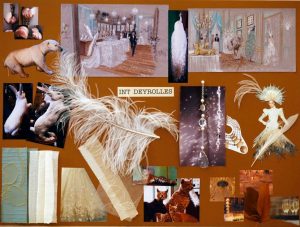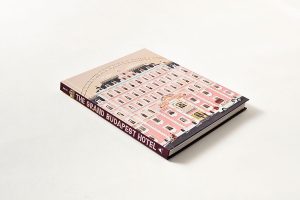What is a mood board and how can they be used small business owners.
A mood board is merely a visual collage of images, colours, textures, and other elements that represent a particular feeling or aesthetic. It is a tool that can be used to communicate ideas and inspiration, and to help make decisions about a creative project.

Mood boards can be used for a variety of purposes, such as:
- Branding: A mood board can be used to develop a visual identity for a brand, including its logo, colours, fonts, and overall style.
- Interior design: A mood board can be used to create a vision for the style and atmosphere of a room or space.
- Product design: A mood board can be used to generate ideas for the look and feel of a new product.
- Event planning: A mood board can be used to create a cohesive aesthetic for an event, such as a wedding or party.
Famous Mood Board Examples.
Annie Seibel’s mood board for the film Midnight in Paris.
This mood board helped Seibel to create the visual world of the film, which is set in 1920s Paris. The mood board includes images of famous artists and writers from that era, as well as images of the city of Paris itself.


Wes Anderson’s mood boards for his films.
Wes Anderson is known for his visually distinctive films, and he uses mood boards extensively to develop the look and feel of each film. For example, the mood board for his film The Grand Budapest Hotel includes images of Art Deco architecture, European pastries, and vintage fashion. The book that contained all these mood boards and inspiration is The Wes Anderson Collection: The Grand Budapest Hotel Matt Zoller Seitz you can read more about it here.


Behance curated moodboards inspired Wes Anderson himself here.
- Marc Jacobs’ mood board for his Louis Vuitton Spring/Summer 2008 collection. This mood board helped Jacobs to develop the nautical theme of his collection. The mood board includes images of sailors, boats, and the sea.
The mood board for the 2012 London Olympics.
This mood board was used to develop the overall look and feel of the Olympic Games. It includes images of British culture, such as the Union Jack flag, Big Ben, and the London Eye.
The mood board for the album cover of Beyoncé’s album Lemonade.
This mood board helped to create the visually stunning and powerful album cover. The mood board includes images of Beyoncé in traditional African clothing, as well as images of nature and animals. You can read more about that here
The mood board for the interior design of the Ace Hotel in New York City.
This mood board helped to create the eclectic and stylish interior design of the hotel. The mood board includes images of vintage furniture, mid-century modern design, and industrial elements. You can read more about it here
Mood boards are used for all sorts of projects from films to apparel such as this example from KPS Apparel.

Mood Boards for Small Business.
Here’s how it can be valuable for solo or small business owners:
- Visual Inspiration: Mood boards provide a curated collection of visuals that inspire and guide the design process. They help business owners communicate their vision to designers, ensuring they’re on the same page regarding the desired style and mood.
- Clarity in Branding: For small businesses, having a consistent brand identity is crucial. A mood board can bring clarity to your brand’s visual elements, like logos, colours, and fonts, which is essential for building a recognizable brand.
- Cost-Efficient Design: Small businesses often have limited design budgets. A mood board is a cost-effective way to experiment with design ideas before committing to final designs. It prevents unnecessary revisions and keeps costs in check.
- Consistency Across Platforms: A mood board helps maintain a cohesive look across different marketing materials, such as websites, social media, and printed materials. This consistency reinforces your brand’s image.
- Collaboration: Mood boards encourage collaboration between business owners and designers. They can easily provide feedback and suggestions based on the visuals presented in the mood board.
For solo business owners and small business owners, mood boards can be a particularly useful tool. They can be used to:
- Clarify your brand vision. A mood board can help you to define your brand identity and values, and to communicate them to your target audience.
- Develop a cohesive visual aesthetic. A mood board can help you to create a consistent look and feel for your website, social media, and marketing materials.
- Generate creative ideas. A mood board can be a source of inspiration for new products, services, and marketing campaigns.
- Make decisions. A mood board can help you to make informed decisions about your brand and business, such as choosing colours, fonts, and images.
To create a mood board, start collecting images, colours, textures, and other elements that represent the feeling or aesthetic you want to convey. You can find inspiration in magazines, online, or even in your own personal collection of objects. Once you have gathered your materials, arrange them on a board or in a digital file in a way that creates a visually appealing and meaningful collage.
Tips for creating a mood board for your solo business or small business.
- Be clear about your goals. What do you want to achieve with your mood board? Are you trying to develop your brand identity, create a cohesive visual aesthetic, or generate creative ideas?
- Choose images that resonate with you. What kind of feeling or aesthetic do you want your business to evoke? Select images that evoke those emotions and feelings.
- Don’t be afraid to experiment. There are no rules when it comes to creating a mood board. Play around with different arrangements and combinations of elements until you find something that you love.
- Use your mood board to make decisions. Once you have created a mood board, use it as a reference when making decisions about your business, such as choosing colours, fonts, and images for your website and marketing materials.
Examples of how solo business owners and small business owners can use mood boards.
- A coffee shop owner could create a mood board to capture the feeling of a cozy and inviting space. They could include images of warm wood tones, comfortable seating, and delicious-looking coffee drinks.
- A clothing designer could create a mood board to develop the aesthetic of their new collection. They could include images of fabric swatches, silhouettes, and inspirational looks.
- A web designer could create a mood board to communicate their client’s vision for their new website. They could include images of fonts, colours, and layouts that they think would be a good fit for the client’s brand.
- A new fitness centre can use a mood board to work out the aesthetics, design and feel of their new space.
No matter what your business is, a mood board can be a valuable tool for clarifying your vision, developing a cohesive aesthetic, and generating creative ideas.
How design agencies use mood boards for branding.
Design agencies use mood boards to help their clients to develop and refine their brand identities. A mood board can be used to communicate the overall feeling, tone, and aesthetic of a brand. It can also be used to explore different creative directions and to get feedback from the client.
An example in developing branding.
A design agency (Rawmarrow) in this example, is working with a new client to develop their brand identity. The client is a sustainable clothing company, and they want to create a brand that is both stylish and eco-friendly.
After discussions, research and information gathering we start creating a mood board for the client. The mood board includes images of sustainable materials, such as organic cotton and recycled polyester. It also includes images of clothing that is both stylish and comfortable.
The mood board is presented to the client. The client is happy with the overall direction of the mood board, but they want to make a few changes. They ask us to include more images of people wearing the clothing, and they also want to see a wider range of colours.
We make the requested changes to the mood board, and the client is now happy with the final product. We can now use the mood board to guide the development of the client’s brand identity, including their logo, colours, fonts, and overall aesthetic.
Overall, mood boards are a valuable tool for both small business owners and design agencies. They can be used to clarify brand vision, develop a cohesive visual aesthetic, generate creative ideas, and make decisions.
When does Rawmarrow use Mood Boards?
Rawmarrow uses mood boards for clients in some cases and not in others, depending on a number of factors, including:
- The client’s needs and preferences. Some clients have a clear vision for what they want, and they don’t need the help of a mood board to communicate it. Other clients may be less sure of what they want, and find the visual mood board a helpful tool for exploring different ideas and getting feedback.
- The scope of the project. A mood board can be especially helpful for complex projects, such as branding or website design. It can help to ensure that everyone involved in the project has a shared understanding of the desired aesthetic. For smaller, more straightforward projects, a mood board may not be necessary.
- The timing of a project. Mood boards can be time-consuming to create, so for clients with tight timelines, a mood board may not be feasible.
Here are some specific examples of when Rawmarrow might use a mood board for a client:
- A new business owner who is developing their brand identity.
- A company that is redesigning its website.
- A product designer who is creating a new product line.
- An interior designer who is working on a new project.
Sometimes we create a pinterest board to collaborate with clients to share ideas, sometimes clients will have created a board prior to working with us- and they share that with us to kick start the process. Once we actually used a mood board to help a client write their business plan….(yep we actually did lol, that’s a whole other post, some people find images sexy but not words. We got there in the end though!).
Here are some examples of when Rawmarrow might not use a mood board for a client:
- A client who has a very clear vision for what they want and doesn’t need help communicating it.
- A small, straightforward project, such as designing a flyer or brochure.
- If we are able to obtain a comprehensive existing visual reference or clear guidelines have been set we won’t use a mood board simply for the sake of it. In some cases, a client may already have a well-established visual identity or a clear set of design guidelines in place. In such situations, creating a mood board might be redundant, as we can work directly with the existing design assets and specifications provided the client. This can streamline the design process, save time, and ensure that we align closely with the client’s established branding.
Ultimately, the decision of whether or not to use a mood board for a client is made on a case-by-case basis. Rawmarrow takes into account the client’s needs, preferences, budget, and the scope of the project when making this decision. If you’re thinking about using a mood board for your own business, I hope this blog post has given you some helpful information to get you started. If you have any questions or would like our guidance, please contact us.



